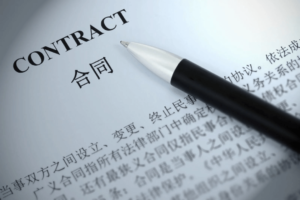In the strategic enforcement of intellectual property (IP) rights, cease-and-desist letters are a fundamental tool used to address and halt alleged infringements. When these legal measures are taken in China, adapting the strategy to align with local practices and laws is crucial for success. This article explores the essential considerations for drafting cease-and-desist letters within the Chinese IP framework, ensuring they are both effective and compliant with national standards.
Table of Contents
ToggleComprehending the Chinese Legal Context
The effectiveness of a cease-and-desist letter within China critically depends on a thorough comprehension of the local legal landscape, particularly as it pertains to intellectual property rights. China’s legal system is distinct with an elaborate framework of laws and regulations specifically designed to govern intellectual property. This includes several types of protections under which intellectual property may fall, such as patents, copyrights, trademarks, and protections against unfair competition.
For a cease-and-desist letter to be seen as valid and to carry weight in negotiations or potential legal battles, it must not only reference these specific laws but also align closely with them. This means the letter must be meticulously crafted to reflect the intricacies and specific provisions of laws such as the Chinese Patent Law, which details what types of inventions can be patented, the process for registration, and the rights of the patent holder. Similarly, understanding the Trademark Law of China is crucial, as it outlines the procedures for trademark registration, the rights conferred by registration, and the penalties for infringement.
Moreover, the Anti-Unfair Competition Law must be considered, which protects businesses from acts of deception, trademark infringement, and other business-related torts that can be considered unfair competition. This law is particularly relevant when drafting cease-and-desist letters that deal with issues beyond straightforward patent or copyright infringement, such as misleading advertising or illegal trade practices.
Ensuring that the cease-and-desist letter adheres to these specific legal standards is essential for the communication to be taken seriously. It must not only deter the infringer with its authority but also withstand scrutiny under the legal system if the dispute escalates to litigation. The letter should, therefore, be precise, citing relevant legal articles and demonstrating a clear violation of specific rights under Chinese law. This level of detail not only strengthens the position of the rightsholder but also signals a preparedness to pursue further legal action if necessary, thereby lending the letter an air of authority and determinacy.
Importance of Language
In the context of international legal practices, especially in intellectual property disputes, the accuracy and clarity of language used in legal documentation are paramount. This is particularly critical in cease-and-desist letters, where the objective is not only to communicate a legal argument but to do so in a way that minimizes the potential for misunderstandings and maximizes the potential for compliance. In China, the use of Mandarin Chinese in drafting these documents is not just a recommendation—it is a necessity for several compelling reasons.
Firstly, Mandarin Chinese is the official language across the People’s Republic of China, used in government, business, and daily communication. Drafting a cease-and-desist letter in Mandarin ensures that the document is accessible to its intended recipient, without the barriers that might be introduced by language translation. It removes any ambiguity that might arise from language translation errors, which can be particularly problematic in legal contexts where specific terminology may have significant implications.
Moreover, using Mandarin Chinese in legal correspondence goes beyond mere practicality—it also serves as a gesture of respect and understanding towards Chinese cultural and business practices. Legal communications that respect local language preferences are more likely to be taken seriously and considered credible. This is especially important in a cease-and-desist letter, where the tone and formality of the communication can significantly impact the recipient’s response.
Specifying Chinese Intellectual Property Laws
An effective cease-and-desist letter should clearly cite the specific Chinese laws applicable to the case. This may involve referencing various segments of IP law, including:
- Trademark Law: Protects distinctive signs that distinguish the goods or services of one entity from those of others.
- Patent Law: Provides protection for inventions that are new, non-obvious, and capable of industrial application.
- Copyright Law: Offers protection for original works of authorship including literary, dramatic, musical, artistic, and certain other intellectual works.
- Anti-Unfair Competition Law: Safeguards business interests against deceptive, fraudulent, or other unfair competitive practices that might distort normal business activities.
By explicitly referencing these laws, the letter not only reinforces its legal standing but also highlights the seriousness with which the infringement is viewed.
Setting Realistic Expectations and Deadlines
Setting realistic demands and deadlines is crucial in formulating cease-and-desist letters, particularly within the framework of China’s intellectual property laws. This practice not only aligns with legal efficacy but also resonates well with typical business operations and legal processes prevalent in China. Establishing realistic and practical expectations for compliance is not just about demanding cessation of infringing activities; it’s about facilitating a pathway to resolution that both parties can reasonably manage.
Realistic demands in the cease-and-desist letters should be clear and achievable. For instance, if the letter demands the cessation of manufacturing a patented product, it should also consider the time and logistics required for the infringer to halt production. This includes considering their inventory cycles, production schedules, and distribution chains, which might necessitate a phased approach rather than an immediate stop. By accounting for these aspects, the rightsholder shows not only a command of legal rights but also a practical understanding of business operations, which can lead to more amicable compliance.
Similarly, the deadlines set in these letters must be thoughtfully determined. They should provide enough time for the infringer to adequately assess the situation, seek legal counsel, and respond appropriately. Immediate deadlines can create unnecessary pressure, potentially leading to hostile responses or non-compliance. Conversely, excessively lenient deadlines may not convey the urgency of the issue, potentially allowing the infringing activities to continue causing damage.
Therefore, setting these deadlines with a balance between firmness and fairness is essential. It’s about creating a sense of urgency without being unreasonable. For example, rather than demanding an immediate response within a few days, a two-week period may be more appropriate for the infringer to begin addressing the issues raised. This timeline reflects an understanding of the legal and operational realities that the accused party faces and fosters a more cooperative environment for resolving the dispute.
Common Pitfalls in Drafting Cease-and-Desist Letters in China
Crafting effective cease-and-desist letters in China involves understanding not only what to include but also what to avoid. One of the principal mistakes is relying on a generic letter format, which might work in a more familiar legal setting but can prove ineffective in China’s specialized legal framework. These standard templates often fail to incorporate the nuances of Chinese intellectual property law, resulting in a communication that may not be taken seriously or could even be dismissed by recipients.
Language selection is another critical factor. Cease-and-desist letters must be drafted in Mandarin Chinese to ensure that the message is clear and unequivocally understood. Translating legal terms and ensuring that the legal implications are accurately conveyed prevents misinterpretations that could compromise the effectiveness of the letter.
A further error is insufficiently citing the specific Chinese laws and regulations that apply to the case. For the letter to hold legal weight and demonstrate the seriousness of the infringement claim, it must reference relevant statutes such as the Chinese Trademark Law, Patent Law, Copyright Law, or Anti-Unfair Competition Law. This not only strengthens the legal basis of the claim but also ensures that the recipient understands the specific legal grounds of the infringement.
Lastly, the setting of unrealistic demands and deadlines can be a significant blunder. The demands made in a cease-and-desist letter should be feasible, giving the recipient a reasonable timeframe to comply. Deadlines that are too stringent may be impossible to meet, leading to immediate non-compliance and potentially complicating further legal actions.
Avoiding these common errors enhances the effectiveness of cease-and-desist letters in China, facilitating a smoother resolution to intellectual property disputes and reinforcing the rights of the holder under Chinese law.
Conclusion
Drafting cease-and-desist letters in China requires a thoughtful approach that includes a thorough understanding of the local IP laws, the use of the local language, specific references to applicable legal statutes, and realistic compliance expectations. By addressing these key aspects, rightsholders can more effectively manage and protect their intellectual property rights within China’s dynamic market. Such meticulous preparation not only enhances the enforceability of IP rights but also respects and integrates the nuances of the local legal environment.








